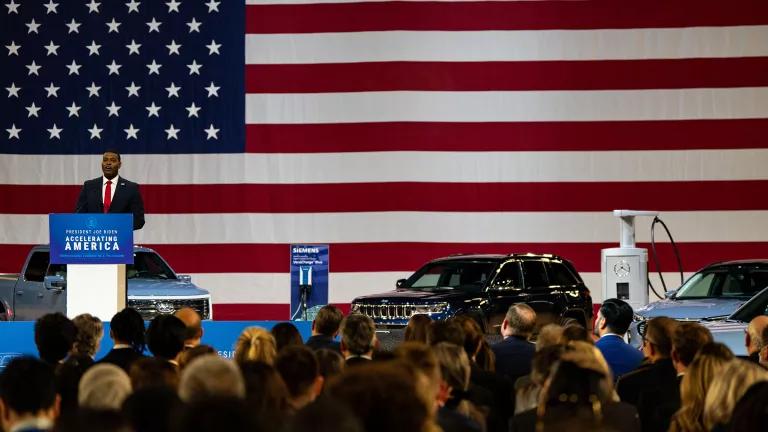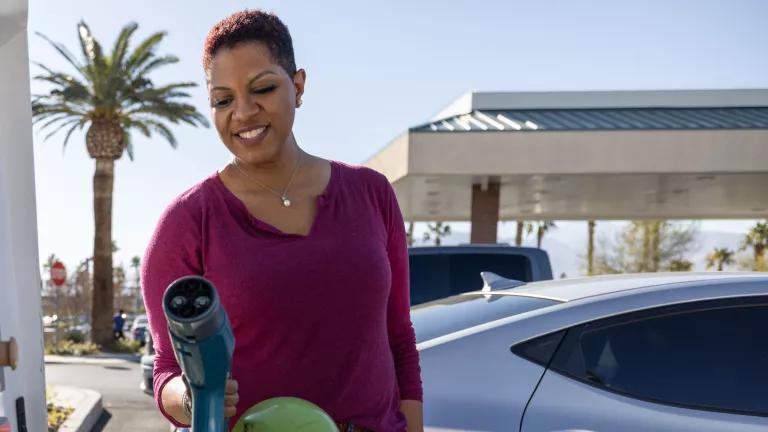Starting the Transportation Decarbonization Marathon
Four federal agencies unveiled their National Transportation Decarbonization Blueprint this week. Here's what that means for our future.

A publicly accessible PlugNYC electric vehicle charging station in Brooklyn, New York.
Kristen Walsh/NRDC
About four months ago, four federal agencies quietly published a memorandum of understanding committing to working jointly toward a “clean, safe, accessible, equitable, and decarbonized transportation system for all,” including a strategy for decarbonizing the entire transportation sector. This week, staff for these agencies (the U.S. departments of Energy, Transportation, and Housing and Urban Development, as well as the Environmental Protection Agency) released it publicly, dubbing it the National Blueprint for Transportation Decarbonization.
This comes out at a time when there’s a tremendous amount of excitement about the increased practicality of vehicle electrification, as my colleagues have written about here, as Atlas Public Policy tracks here, and as inspiring books like Electrify have described. And no wonder—in addition to the National Electric Vehicle Infrastructure program’s $7.5 billion investment in electric vehicle charging infrastructure included in 2021’s historic infrastructure law, last year’s Inflation Reduction Act included billions of dollars in incentives for clean vehicles. And upcoming clean cars and trucks and fuel economy rules will complement these investments to support this transition while ensuring the highest-possible efficiency and cleanliness of combustion engines sold in the interim.
This new blueprint, however, rightly takes a more expansive approach to transportation decarbonization. Its description of the focus on federal activities over the coming decades is a peek into the future: The 2020s are about “turning the tide” with research and investments aimed at deployment; the 2030s are about scaling up deployment; the 2040s are about “completing the transition” to a preferred future. It’s fitting that the descriptions of work are most specific for this decade and become sparser and vaguer over time.
As a marathon runner, I appreciate this long view. And details matter too. After this three-decade trajectory description, a table lays out specific initiatives and investments for reducing emissions from different parts of the transportation sector, from the largest (light-duty vehicles) to the smallest (pipelines) in a helpful table summarizing the contents of Chapter 5.
The agencies first lay out the problems in a chapter on “Transportation Challenges Today.” Among those challenges are changing mobility needs and the burden of transportation costs for consumers—about 20 percent of the average annual household budget as of 2019, second only to housing. The blueprint makes affordability a priority, including an actual numeric target for reducing the cost to households by “at least 5 percent by 2030.”
Then the report lays out detailed solutions for emissions in each subsector: pipelines; light-, medium-, and heavy-duty vehicles and buses; off-road vehicles; rail; maritime; and aviation. This is important content, providing some of the details for implementing decarbonization measures across the transportation sector.
What I found heartening is that the government was clear that it will pursue additional strategies beyond vehicle electrification, describing the components of a three-pronged strategy for getting there and specifically aiming for a transportation system that is:

The substrategies are comprehensive, synergistic, and reminiscent of climate stabilization wedges as well as of Bill McKibben’s observation in 2006 that there’s no silver bullet for climate change—instead, we need “silver buckshot.” This set of strategies is crucial, since it really does make this a whole-of-government blueprint. Based on their missions, staff expertise, and policy tools, the Department of Energy (DOE) and Environmental Protection Agency (EPA) can take the lead on clean and efficient strategies while the Department of Transportation (DOT) and Housing and Urban Development (HUD) cover convenience and other efficiency strategies.
The report notes how these substrategies relate to, and lean on, one another. As the accompanying fact sheet states, “While the first two strategies will contribute to reducing GHG emissions and produce significant co-benefits, transitioning to clean options is expected to drive the majority of emissions reductions.” Yet the authors also note that “successfully implementing the first two emissions reduction strategies will ease the challenges associated with rapidly deploying clean vehicles and fuels and replacing fossil fuels with clean alternatives.”
The report also prioritizes equity and environmental justice, describing the unfair and uneven distribution of costs and benefits from policy and investments (see pages 16 and 48). Examples include highways rammed through Black and brown neighborhoods in Baltimore, New Orleans, and many other cities; redlining that segregated communities across America; inadequate public transportation service; and a heavier transportation cost burden. DOT and HUD have a special, historic opportunity to boost equity and deliver on the promise of the Justice40 initiative.
Another recurring theme is nimbleness, which will be a huge challenge for these large federal agencies. But for this 30-year blueprint to succeed, they will have to be nimble in reacting and adjusting to the changing market and societal context, in addition to unexpected challenges, over that time frame.
Importantly, the report identifies land use reform as a critical tool to making non-vehicle transportation choices—the most “decarbed” transportation option—more convenient. Regarding land use planning as part of convenience, the blueprint is quite clear:
“Local and regional land-use decisions and the design of our communities and mobility systems are major drivers of travel behavior, and in turn, transportation emissions. Improving mobility systems to reduce emissions and provide improvements in safety, traffic, and quality of life requires careful local or regional land-use planning, improved freight logistics, and harnessing emerging trends like telework and the sharing economy.”
Reading this part of the blueprint reminded me of what Secretary of Transportation Pete Buttigieg had penned in the introduction to the American Planning Association’s latest set of essays on the state of transportation planning:
“The undertaking of the years ahead, when it comes to our infrastructure, will require us to think in an interdisciplinary fashion, across traditional siloes. Here, I am mindful that many in the planning community have been working in just this way, which does not always come as naturally to the federal executive branch. A classic example of this is transit-oriented development, which local communities have often led with and which we are striving to better support in my department and our sister agencies across the administration.”
True to his word, this blueprint smashes siloes between agencies by acknowledging issues beyond clean cars, especially its focus on convenience (including local zoning reform, which is a particularly hot topic right now). There is much to like here regarding transit-oriented development, which, as I’ve said and as a recent report describes, can help address our affordable housing crisis.
What’s next? First, the government still needs more specific goals for different transportation modes. While light-, medium-, and heavy-duty vehicles have specific performance targets for chargers, sales, and federal fleet procurement numbers, other transportation types, at best, “need to establish specific targets” placeholders. Performance targets are important.
Hopefully, such targets will be adopted by agencies in the action plans that the blueprint claims are next. I hope those will be forthcoming soon because they must light the path forward in the near term (i.e., through 2026, when the federal transportation law must be reauthorized by Congress). Speaking of the near term, the other key question is what states should do, now that there is a whole-of-government blueprint for transportation decarbonization. Has your state issued a similar plan to coordinate the work of your state energy office, department of transportation, department of environmental protection, and housing finance agency? States must also step up next.
This blueprint is the starting gun. Now federal agencies, states, and companies must start running on a thoughtful path toward producing a transportation sector transformation. It’s going to be a fun race!



